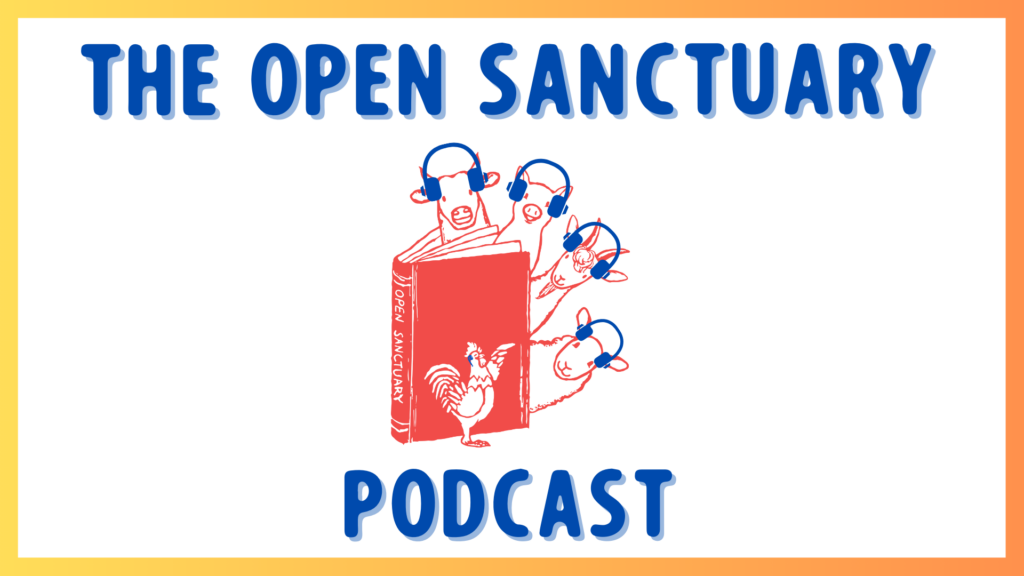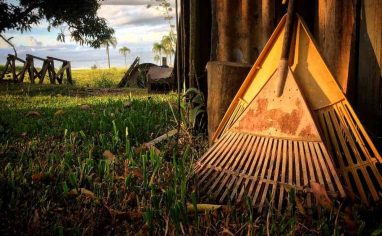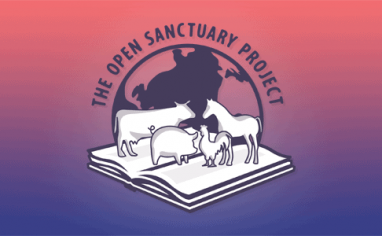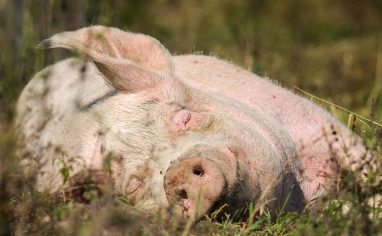
Subscribe To The Open Sanctuary Podcast
If you’d like to get the latest episodes of The Open Sanctuary Podcast, you can subscribe for free on all Podcast platforms, including Apple Podcasts and Spotify!
Episode Notes
In this episode of The Open Sanctuary Podcast, Executive DirectorThe individual formally in charge of final decision making at an organization, who sometimes works closely with the organization’s Board of Directors. Sometimes a Founder is an Executive Director, especially early in a nonprofit’s growth stages. Mckenzee and NonprofitA non-governmental organization whose primary purpose is something other than selling goods or services. Specialist Julia discuss ten critical questions that you should ask yourself before you start a sanctuary! This resource is excellent for those new to the sanctuary movement and a helpful refresher for established sanctuaries and rescue organizations. It serves as a guide to some of the many considerations you will need to consider as you embark upon or continue to provide forever lifelong compassionate care to animals. Along the way, we will point you to our free resources, which will help you tackle these questions more easily!
—
This Episode’s Referenced Open Sanctuary Project Resources:
- So, You Want To Start A Farmed Animal Sanctuary | The Open Sanctuary Project
- The Open Sanctuary Project’s ‘So You Want To Start A Sanctuary’ Brochure | The Open Sanctuary Project
- Estimating Species Lifetime Care Costs At Your Animal Sanctuary | The Open Sanctuary Project
- Recognizing And Managing Compassion Fatigue At Your Animal Sanctuary | The Open Sanctuary Project
- Recognizing And Preventing Burnout At Your Animal Sanctuary | The Open Sanctuary Project
- Determining Your Animal Sanctuary’s Capacity For Responsible Care | The Open Sanctuary Project
- How To Create An Effective Rescue Policy For Your Animal Sanctuary | The Open Sanctuary Project
- Resources On Budgeting And Fundraising | The Open Sanctuary Project
- Fostering Positive Relationships Between Animal Sanctuaries | The Open Sanctuary Project
- Resources On Volunteer And Worker Considerations | The Open Sanctuary Project
- Accuracy And Transparency: Two Critical Responsibilities Of Your Farmed Animal Sanctuary | The Open Sanctuary Project
- An Introduction To Educational Opportunities Well-Suited For Microsanctuaries | The Open Sanctuary Project
- The Microsanctuary Resource Center
Episode Transcript (Auto-GeneratedThe following content was transcribed through an automated process and may contain transcription errors or misspellings.)
Julia Magnus: Welcome to another episode of the Open Sanctuary Podcast. I’m Julia, the nonprofit specialist, and I’m here with Mckenzee Griffler, our beloved executive director. We’ve mentioned before on this podcast that one of the most frequent questions we receive is, “I’d like to start an animal sanctuary. How do I do it?” So, let’s just say it’s really delightful that so many people want to help animals in this way. But with that said, we’d also like to say for those who are new to the world of rescue and sanctuary, there are quite a lot of things you’ll want to consider before you start your journey down this road. And as rewarding as it can be to care for animals in need in a sanctuary context, there are inevitably going to be significant challenges as well. So, we’ve created a list of 10 questions that you should ask yourself before you start a sanctuary. We do have a full resource on this question as well as a lovely brochure you can download and some additional resources we’ll mention as we discuss this. So, Mckenzee, you want to get started and dive into these questions?
Mckenzee Griffler: Absolutely. The very first question in our list of 10 questions is, do I have any special skills or volunteer time that I could share with existing sanctuaries or organizations in my region that could help strengthen their missionThe stated goals and activities of an organization. An animal sanctuary’s mission is commonly focused on objectives such as animal rescue and public advocacy. and help more animals inside or outside of a sanctuary environment?
Julia Magnus: Yes, that is such an important one because one thing that we always always recommend for anyone interested in starting their own sanctuary is that they spend some time at numerous sanctuaries either as a volunteer, an intern, in a formal role like a board member for at least a year if not longer. So that can help with a number of different things. What is your take on why that’s important, Mckenzee?
Mckenzee Griffler: Well, first of all, working with animals on a regular basis is what you’re essentially signing up to do if you start an animal sanctuary or a rescue. So, getting to understand the dynamics in yourself and your capacity as well as what it’s like to work on a team to help animals and how the area that you live in, what their context is with these animals, what species you feel compelled to work with, who you might find more challenging to work with. All of these things are really great things to figure out in the context of an existing organization because it can help you really understand the nature of the work and experience the challenges that do come up in an animal sanctuary or rescue environment. And not only are we talking with the animals, but also interpersonally, interorganizationally in terms of regulations, in terms of environmental challenges and weather challenges and the difference between helping a gooseUnless explicitly mentioned, we are referring to domesticated goose breeds, not wild geese, who may have unique needs not covered by this resource. through molting in the spring versus the winter. All of these things, especially if it’s an organization similar to one that you’ve envisioned, they can really help you get a much more clear picture of the commitment that you’re looking at. But at the same time, it’s also helping you build community connections. It’s helping you understand what’s already going on in your community, and it’s giving you an opportunity to volunteer and help out another organization, which is always a wonderful thing. And I think all of this stuff can be so helpful in either at the end of it, you decide this is really tough work. I’d like to continue just volunteering at an organization every once in a while, which is a great outcome because then you’re a volunteer for an animal organization that could probably use your help. Or you decide, no, I really do want to start my sanctuary and it’s going to fill this niche that these organizations might not be fulfilling already either due to their own limitations or species mix or their own capacity that they’re just not doing and you have an insider look at how you want to craft your organization to address whatever challenges you found. So even if you’ve decided, I’m definitely going to do it. I’m definitely going to start an animal sanctuary, there’s so much value in volunteering and working with existing animal organizations first.
Julia Magnus: Yeah, I totally totally agree. I think the community aspect of it is really important to me, too, because getting to know who’s around you and what they’re doing is critical to building partnerships can help sustain you long term going forward should you decide to start your own organization. Absolutely. That said, do you want to move on to question number two?
Mckenzee Griffler: Let’s dive into it. Question two, am I prepared for a lifetime commitment to every animal I plan on providing sanctuary to, including providing appropriate care, seeking all necessary veterinary treatments and compassionate end of life care?
Julia Magnus: Yeah, this is a big big deal. When you take in an animal in a sanctuary context with the intention of providing compassionate care for their entire lifetime, you have to consider how long you’ve committed to doing this time-intensive work. Because for farmed animalA species or specific breed of animal that is raised by humans for the use of their bodies or what comes from their bodies. species, you could very well be looking at caring for a chicken up to 10 years, just a cowWhile "cow" can be defined to refer exclusively to female cattle, at The Open Sanctuary Project we refer to domesticated cattle of all ages and sexes as "cows." for 20 and a goose for 30.
Mckenzee Griffler: Absolutely. And a lot of sanctuaries go in with visions of taking in far more than one resident, which really is pushing out that time commitment further for each new life that you’re providing that sanctuary to. So starting an animal sanctuary naturally means that everyone you’re committing to is depending on you for their entire life, including a peaceful end of life. And that is just as critical an element of care as a beautiful life. So until a founderSomeone who starts an organization. A Founder may or may not also be the Executive Director of an organization. moves on from an organization that they start, all of these lives are the founder’s responsibility.
Julia Magnus: Yeah. And if you want, we have a wonderful resource which is a lifetime care cost calculator which is available on our site opensanctuary.org. It’s listed in the show notes. It will give you a better sense of what lifetime expenses can look like for different farmed animal species and is a really helpful tool in determining what your capacity will be in the long run.
Julia Magnus: Yeah. Question number three. If nobody else can help out, can I provide daily care to every animal at the sanctuary without any time off or relief for the foreseeable future?
Mckenzee Griffler: Yeah, that’s a big one because all of your residents are going to require daily care. That’s going to include feeding, watering, habitat cleaning, regular health checks by your onsite caregivers and regular vet visits. And it doesn’t matter what the weather is. It doesn’t matter how you feel. Those needs exist regardless if there’s no one else qualified and willing to help you out. You are responsible for this daily. And this isn’t us trying to scare you out of it or to say that this is unreasonable. This is simply a reality of starting an animal organization. Should you not get the kind of volunteer recruitment or staff that you were maybe envisioning at the beginning. So, this is a reason why if you do embark on starting a sanctuary, we are always recommending that consider how many residents you’re committing to, especially early on, and whether this is something that could be sustainable for you. And potentially, you might decide that what would feel a lot better for you is rather than dreaming of a large, you know, 50-acre farm with all these residents, maybe a micro sanctuary is a completely valid and wonderful thing to do for a smaller population of animals. And therefore, you don’t have to worry about this capacity overtaking your ability. And you know, if you are experiencing compassion fatigueA form of Secondary Traumatic Stress Disorder that can affect anyone serving individuals who have experienced or are currently experiencing trauma. and burnoutA physical and emotion reaction to prolonged, unmanaged workplace stress., which are both common and devastating hazards in the sanctuary world, especially if you’ve already gotten into this work, we do have resources about these two topics. And we would really encourage you to check them out.
Julia Magnus: Definitely. Definitely. Even if you say micro, those can be a hazard. So yeah, it’s important to know the signs, be able to recognize them. Those resources are very helpful in that regard. So how about question four, Mckenzee?
Mckenzee Griffler: Question four. Do I have the strength to turn away animals in need of sanctuary if I do not have the resources or necessary skills to responsibly provide care? And this is possibly one of the most challenging things at any animal organization. It’s the worst. It’s absolutely the worst to, as you inevitably will, have to say no often, sometimes daily, sometimes multiple times a day. And unfortunately, that’s going to happen because taking into account the state of animal agricultureThe human production and use of animals in order to produce animal products, typically for profit., there are so many limitations on how many animals we can care for responsibly, giving good, compassionate, lifelong care. That’s not just about animal agriculture, but just the reality is the lack of resources that nonprofit animal organizations have access to.
Julia Magnus: Yeah. And what that will inevitably end up is either yourself at your organization or maybe you balance responsibility between multiple people, but you’re going to be saying no a lot. And when you say no, you’re also going to be dealing with the disappointment or upset of the people you’re saying no to on top of the very real pain that comes with knowing that you might be an animal’s last chance.
Julia Magnus: Yeah. And that as you mentioned, compassion fatigue and burnout are real. This is probably the main reason I feel burnt out a lot of times doing rescue work, but it all goes back to capacity, right? And we’ve done two other podcasts on the subject of capacity because it’s just that important. And we also have resources that discuss the elements of capacity, which include things like spatial capacity, quarantineThe policy or space in which an individual is separately housed away from others as a preventative measure to protect other residents from potentially contagious health conditions, such as in the case of new residents or residents who may have been exposed to certain diseases. capacity, personnel, financial, regulatory, and emergency response capacity, all of which have to be balanced to make sure your sanctuary is operating sustainably. Yeah. And we also have resources on rescue policies and how to balance this responsibility of saying no. All of these factors are really important to creating a sustainable organization that people can really be a part of for a long time while supporting the people doing this important work.
Mckenzee Griffler: Absolutely. So, all right. What’s our next question now that we’ve dealt with that heavy subject?
Julia Magnus: Now that we’ve had that light talk.
Julia Magnus: Yeah. Question five. Do I have a strong support system in place to help handle the emotional toll of working with vulnerable populations day in and day out? Speaking of heavy subjects, this life is hard, people. It really is.
Mckenzee Griffler: I think people have a certain vision of what it means to operate an animal sanctuary. And if you’re only looking at glossy social media posts, it can be easy to really only see the reward without everything that goes into it. Yeah. And the reality is that when you live with and care for beings who have been through significant trauma, when you witness distressing situations in rescue and look at the consequences of cases of abuse, neglect or hoarding and you experience the stress of caregiving when your residents become ill or when they pass. This is just a lot. It’s heavy.
Julia Magnus: Absolutely. And so that means that it’s really important at the outset of this work before you even start to figure out and nurture and build a support system in your life that includes having mental health care support, having peers you can talk to, having people that understand and being able to release some of this energy because you can’t hold on to this forever. It’s not sustainable for any human. I totally agree. I totally agree. So, speaking of support, that’s what question number six is about, but it’s a different kind of support. Question six, how will I raise money for my sanctuary? And how will I balance that responsibility with my other responsibilities at the organization?
Mckenzee Griffler: Okay, here we go. It’s expensive. It’s very, very expensive. So, not just creating habitats, maintaining them, and paying for utilities and food. There’s vet care. And vet care is absolutely 100% necessary. And yes, even with the best regular vet care you will have emergencies and emergency vet care is also expensive. Even smaller sanctuaries can have tens or hundreds of thousands of dollars of vet bills per year. My tiny little rescue owes our vet $20,000 right now. So, you will need a solid fundraising plan. And you’ll need to have the time to ramp up your fundraising plan because creating a fundraising plan and implementing it are two very different situations. I know that we’ve had at least one podcast episode explaining ways to create a fundraising plan, ways to raise money in an ethical manner for animal sanctuaries. We have all sorts of really great resources on our website, all pertaining to the question of raising money for animal sanctuaries. So, if you are really interested in getting started and starting an animal sanctuary, we would highly recommend that you check those things out before you start your organization. And also consider your capacity and consider your financial capacity as one of those variables when you’re getting started. And really think about what it is that you’re committing to every time you grow your organization, either in terms of space or in terms of residents or in terms of programs because more than likely all of that is going to have a price tag of one kind or another.
Julia Magnus: Yeah. And if you really want to focus on direct care, you’re going to have to find somebody to help you with this because it does require significant investment and a particular kind of mindset to do successfully. So you’ll have to find either staff or volunteers willing to do this. Absolutely. Question number seven. Am I willing to ask for help when I need it? And am I willing to embrace constructive advice from others in the sanctuary community?
Mckenzee Griffler: Yeah, it’s really important to know that as much as you may know when you come into this kind of work, you will always always have more to learn. So even if you’re an experienced caregiverSomeone who provides daily care, specifically for animal residents at an animal sanctuary, shelter, or rescue., you’re probably going to encounter some kind of new situation where you don’t know what to do. So then you have to ask for help.
Julia Magnus: Yeah. And I think it’s so important to realize that the sanctuary community really is a community. And while there will always be situations that you might be going through that no other sanctuary has ever dealt with, there’s going to be a lot of common threads. There’s going to be a lot of situations that rhyme. There’s going to be a lot of knowledge in the community that is really important to listen to. And obviously at Open Sanctuary, we also share a lot of that knowledge. We work with so many sanctuaries and experts and even vets to make sure that sanctuaries have this information and they’re not repeating mistakes that have been made before. But having support and being willing to ask for help and ask for advice from others in the sanctuary community makes so much of a difference when you’re getting started with sanctuary. Yeah, I totally agree. And it can be hard sometimes to ask for help, but we do have resources, including yet another episode of this podcast on how you can cooperate and collaborate positively with other organizations. Fundamentally, fostering these positive relationships are going to make it so much easier to ask for help when you need it and create a dynamic where you’re going to get helpful responses when you do ask.
Julia Magnus: And speaking of other people, question number eight, if I bring on volunteers or staff, am I equipped to manage their well-being, safety, and needs? This is so important to me because yes, we have to center the needs of sanctuary residents. Of course, that’s a key focus of any sanctuary, but we also have to care for the caregivers, and that’s a critical aspect of sanctuary sustainability.
Mckenzee Griffler: Absolutely. Humans are animals as well. That’s something that I always like to say. I think a lot of people sometimes get into help with animals and they say, “Well, I like animals and I don’t like people.” If you’re starting an animal sanctuary, unless you’re self-funding it and all of the residents in your care are people that you can take care of entirely by yourself and it’s totally fine, you’re going to have to talk to people. You’re going to have to accept help from people. You’re going to have to support people and have people support you. And so if you want to have a staff, if you want to have people volunteer, you’re going to have to treat those people well. And if you don’t treat those people well, they’re probably not going to want to be on your staff and they’re probably not going to want to volunteer for you. And creating policies that support people at sanctuaries is hard work. And we have resources that help support a lot of this kind of hard work. And yes, I realize I’m just saying we got more reading for you, but reading is what we got for you. And we highly recommend that you do it, especially before you start so that you can create positive, long-lasting community connections and relationships that help you help more animals.
Julia Magnus: Yeah. And even beyond the fostering positive community aspect of this whole thing, there are legal requirements. So, we have resources that address those as well. And just from pragmatic things like how you can organize shifts and the benefits of cross-training staff and conflict support should you encounter it. All those things are on our site. It’s a good idea to just check them out and this way you may be ready for any snafus that may come up as you build your little sanctuary community.
Julia Magnus: Absolutely. Question nine. If raising money from the public? Can I provide regular updates to the public? And can I handle public criticism whether warranted or not? Wow. Okay.
Mckenzee Griffler: So, we always say that again, as you say, any animal organization and any animal sanctuary, whether they’re a 501(c)(3) or not, they’re a nonprofit. And if you are relying on public support, you’re really going to want to maintain a positive perception in your community so that individuals feel good about supporting you. Financial donations, volunteerism, sharing your socials more so being accurate and transparent is just vital to this. Everyone’s going to get criticized at some point, but maybe we can talk a little bit about some of the best practices to implement to navigate that.
Julia Magnus: Yeah, that is an entirely separate process. That’s an entirely separate set of skills, but you know, having a receptive ear and having a light touch when it comes especially to comments in social media, learning to navigate what is a warranted critique that you can learn something from and versus something that might feel a little bit touchier. All of these things, there can be a lot of nuance between these points, but the bottom line is that if you’re an organization that’s public-facing, if you’re an organization that’s asking for support from the public, if you’re an organization that’s giving updates to the public, all of this stuff is going to come up. So, if you are a kind of person that feels like you just want to do your thing, you want to help your animals, you don’t want to deal with people, you don’t want to deal with other people’s thoughts about what you’re doing, you might want to really think about how you’re organizing your animal organization because being in the public eye, asking for things from the public comes with the responsibility back to that public.
Julia Magnus: Yeah, I think we’d especially encourage you to check out our resource on accuracy and transparency. You are going to have a long homework list in the show notes, but that’ll be in there. And we think that one is really important. It’s really helpful that you check that out so that should you encounter critique, you can maintain and maybe even enhance your reputation with the public depending on how you deal with it. And if you’re saying, “Wow, this is a lot of stuff and this sounds really hard.” The answer is yes. We want you to have a sanctuary, but we want you to have a sanctuary that’s successful. And we want the best for you. And sometimes the best involves a lot of homework.
Mckenzee Griffler: And a lot of honesty. We’re being real with you.
Julia Magnus: Yeah, we are being real with you. And that brings us into the final question. Question number 10. Although I’m sure each of us could come up with another 50. Am I willing to go into this with a plan for others to continue the work I started? If not, who will care for the animals at the sanctuary when I can no longer care for them? This is such a hard one, too. Obviously, the residents of your sanctuary are going to deserve a forever home and commitment to compassion and care, but the only thing that’s inevitable is change. And so, organizational changes and transitions in life and staff, those are going to happen. So, you are going to have to plan for the future, which I know can be an emotional process and difficult logistically, but it’s really necessary when it comes to establishing a sustainable sanctuary long term.
Mckenzee Griffler: And you know, we’re not just talking about when you decide that you’re going to retire from the sanctuary and maybe you physically can’t do the work anymore. Maybe it’s just your time to pass it on to somebody else. Maybe, God forbid, it could be an emergency. And do you have a contingency planA formal or informal course of action planned for certain events, especially emergencies that a sanctuary might face. set up so that somebody else knows what to do in case you can’t continue the work? And the other thing to keep in mind is that animals, regardless of what species you’re taking on, they all have a unique lifespan. And if the purpose of your organization is to help them live a long, happy, healthy life free of exploitationExploitation is characterized by the abuse of a position of physical, psychological, emotional, social, or economic vulnerability to obtain agreement from someone (e.g., humans and nonhuman animals) or something (e.g, land and water) that is unable to reasonably refuse an offer or demand. It is also characterized by excessive self gain at the expense of something or someone else’s labor, well-being, and/or existence., that can be a significant, just like we said at the very beginning, question number one, commitment to these animals. Can you care for them for their entire lives? If you’re done doing this work and you haven’t planned for what’s going to happen to these animals, what’s going to happen to these animals? And the sooner you can make plans, both in terms of emergency situations, but also just when you’re ready to hand off the organization to somebody else, if it’s a 501(c)(3) nonprofit, what does that look like? And the best time to start planning that is before you even have a single animal resident. Absolutely. It’s also worth noting that this comes to mind because a good friend of mine is now passing the directorship reigns of the organization that she founded on to a successor. And while she’ll still always be involved in the organization, that lead role she’s moving on from. And part of the reasoning for that is to bring in new perspective and new energy and somebody who has skills in different areas just to sort of broaden the abilities of this organization to be sustainable long term. So it’s not just you know you die what’s going to happen, it’s just what is the best choice for the focus of your energies, the animals and the organization and that’s a plan that you should start thinking about as you said from the moment you conceive of starting a sanctuary.
Julia Magnus: Yeah. So that was our 10 questions. Things that we do think that if you are genuinely interested in getting into this work, things for you to ponder, some homework for you to look at if any of these kind of touched a soft part in your heart and you said, “Oh, I’m not quite sure. What does that entail?” Good to look at that early. Good to ask those questions now or even, you know, shoot us an email if you’re not quite sure what we were talking about. And we’d be happy to talk a little bit more about it specifically. Definitely. And I want to reiterate a point that you made earlier with regards to alternatives. One thing we mentioned was before you do this, please start by volunteering. Another alternative is as you mentioned the micro sanctuary model. This is just having a small self-sustaining sanctuary that you can cover on your own. And you can kind of do this without facing some of the challenges that might be inherent to operating a larger scale organization. And you might have actually even more pretty unique chance to build narrative and share them with communities who might not be able to access larger sanctuaries. This is something I do myself and I find it very rewarding. So I would encourage you to not only check out our resources, but check out the Micro Sanctuary Resource Center at microsanctuaryA microsanctuary is a small scale community of human and nonhuman (generally “unconventional or farmed”) animal companions, who live together in a chosen shared lifestyle and in commitment to ending the oppression of all beings. Microsanctuaries adhere to the notion that no nonhuman member of the community should “serve a purpose.” Microsanctuaries can exist in any context: rural, suburban, or urban. A microsanctuary can consist of as small a community as one animal and one human caregiver. For more information on microsanctuary please refer to the Microsanctuary Resource Center..org. That’s a great organization. The link is going to be in the notes. So yeah, Mckenzee, do you have anything you want to add to that?
Mckenzee Griffler: I just want to say as a counterpoint, in case it sounded like we were saying there shouldn’t be more animal sanctuaries, we always welcome additional animal sanctuaries in the world. And if none of this deterred you, we are so excited to have you in the animal sanctuary community. And we know that there’s just a lot to know when it comes to animal sanctuaries. There’s people that have been in this work for decades and they still come on our website and they said, “Wow, I had no idea about so many things because it’s just there’s so much to know. And if you can get into this world with a spirit of curiosity and a spirit of what else can I learn?” It’s going to serve you so well. So, thank you genuinely for listening to this podcast. If you were like, “Oh, I want to start animal sanctuary. What should I know?” If you got all the way here and you still feel interested, welcome. We’re so happy that you’re here. One of us. One of us. Well, we really, as I said, are very excited for all the folks who made it through and we hope that this discussion of these questions has been useful not only to folks who want to start a sanctuary, but for those who already have one, some of these things may be useful refreshers. Again, we’ve got this very comprehensive list of resources in the show notes that you can find at opensanctuary.org. And we always welcome your feedback, whether you’d like to shoot us an email, leave us a five-star review. Nudge nudge. If you have ideas for subjects you’d like us to cover, feel free to reach out to us on our site. We got a contact us page. If you like what we do and would like to support our work, we warmly welcome donations. Since we are a 501(c)(3) organization, so your donations will be tax-deductible and help us sustain our mission of providing freely accessible resources so that every sanctuary is a success story.

Got A Podcast Idea? Contact Us!
If you have a topic or question you’d love to hear our staff address on The Open Sanctuary Podcast, please get in touch via our contact form!








